
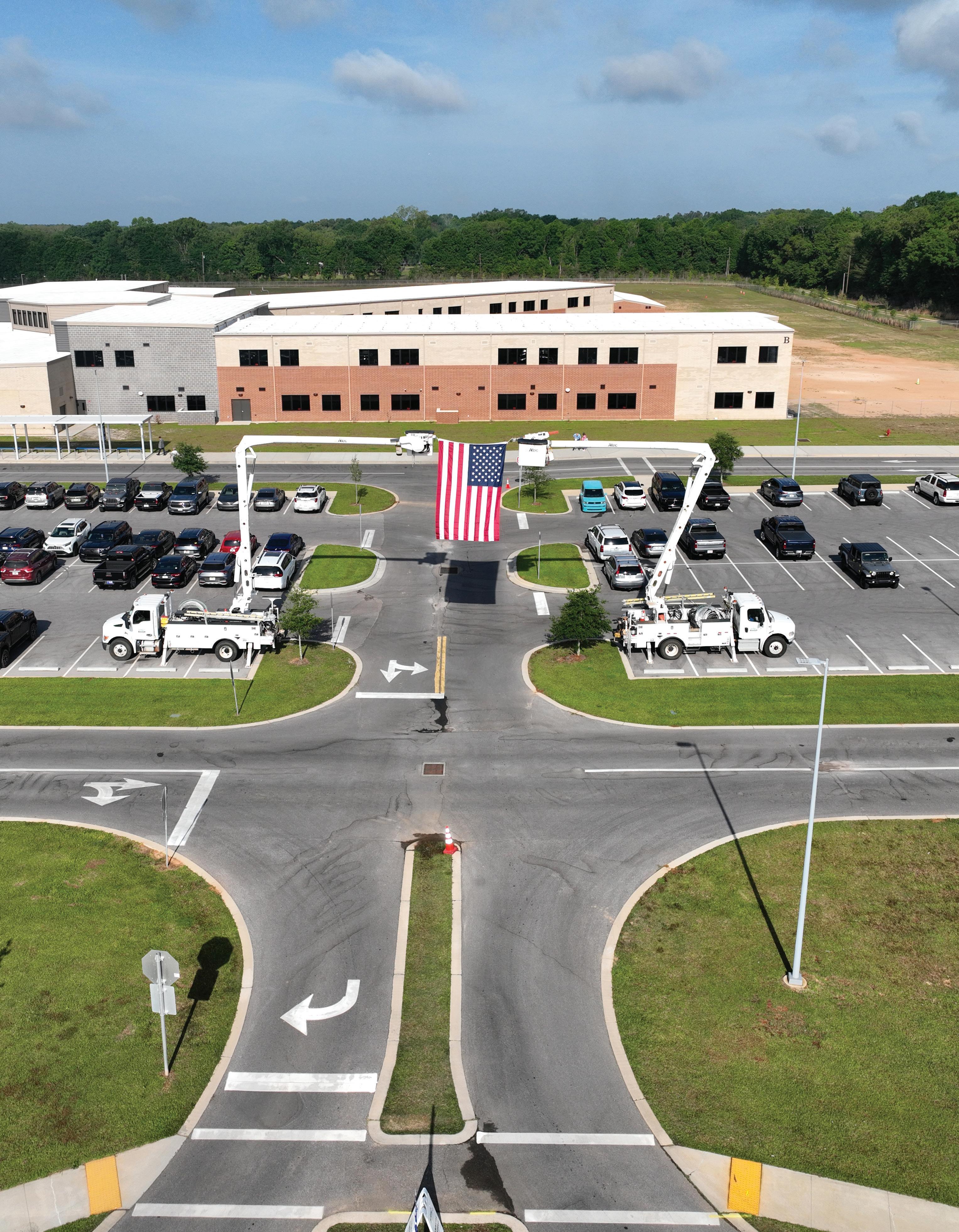



ESCAMBIA RIVER ELECTRIC COOPERATIVE
JUNE 2025




Escambia River Electric Cooperative sees strong turnout and community spirit at 86th annual meeting Page 4

An American flag is hoisted between two EREC trucks outside Wallace Lake K-8 School during EREC’s annual meeting. PHOTO COURTESY OF EREC


Where engineering excellence meets sleek design - a lightweight, safe, customizable, and stylish scooter for UNLIMITED FREEDOM. Numerous scooters with various features and capabilities are on the market, making it crucial to select the one that best suits your requirements.
At the age of 56, a back operation left me dependent on a cane, significantly impacting my daily life. Simple tasks like going to the store or meeting friends became challenging, and I even had to cancel a long-awaited anniversary trip to Italy.


Airline approved. Spacious legroom, comfortable seat



My husband purchased a scooter for me, but it was cumbersome and uncomfortable for everyday use, leaving me feeling more constrained than liberated. However, everything changed when I came across the ATTO SPORT. This remarkable scooter proved to be a game changer. Not only is it robust and reliable, but it also conveniently splits into two pieces, allowing me to effortlessly lift it into my car trunk on my own. I was even able to stow it in the overhead compartment on the plane, enabling us to finally take that trip to Italy! I am now independent once more, able to go wherever I please and do so with a striking sense of style. In fact, I now find that my husband struggles to keep up with me!




Independence and convenience: Easy to use and conveniently folds into a compact suitcase size for simple storage. It easily separates into two parts in seconds, with the heaviest piece weighing just 37 pounds, making it easier to lift into your car trunk.


Go anywhere: Conquer any terrain with puncture-proof, shock-absorbing tires and a 4-inch ground clearance. Equipped with electronic stability control for added safety on descents and turns, it is also flight-approved, ideal for air travel and cruise ships. With a driving range of up to 12.5 miles (25 miles with the XL battery), a top speed of 6.2 MPH, and a maximum weight capacity of 300 pounds, this durable scooter is designed for longevity.
Top-Notch Engineering: Guaranteeing both comfort and durability, this scooter offers ample legroom and a big comfortable seat. The ATTO is super portable and lightweight, and still rides like a heavy-duty scooter.
Unmatched Stylish Design: You deserve a mobility solution that doesn't just get you from A to B but makes you feel great while doing so. ATTO stands out from the crowd with its stunning design.
Splits into 2 lightweight parts for



Folds in 3 seconds, rolls like a trolley suitcase




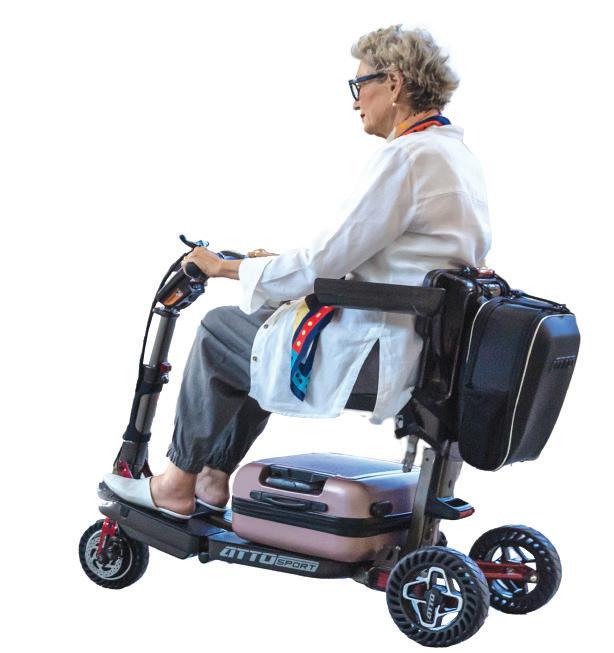

June 2025 • Volume 14, No. 8
CEO Michael Shepard
VICE PRESIDENT OF CONTENT Leon Espinoza
EDITORIAL DIRECTOR Chasity Anderson, CCC
DEPUTY EDITORIAL DIRECTOR
Noble Sprayberry
SENIOR EDITOR Jennifer Paton, CCC
FLORIDA CURRENTS EDITORS
Valeri Saldanha Rosa; Sable Riley, CCC
ASSISTANT EDITORS Victoria Hampton, CCC; David Herder, CCC
ASSOCIATE EDITOR
Nina Todea
PUBLICATIONS PRODUCTION
SENIOR MANAGER
Elizabeth Beatty
SENIOR PUBLICATIONS COORDINATOR
Alyssa McDougle
Members acknowledge that $4.49 a year, plus postage, is the cost to publish 12 issues a year of FLORIDA CURRENTS ISSN 23276304 (USPS 8300). Published by Pioneer Utility Resources Inc., 5625 NE Elam Young Pkwy. Ste. 100, Hillsboro, OR 97124—a not-for-profit Oregon cooperative corporation—the magazine serves the communication needs of consumerowned electric utilities in Florida. Preferred Periodicals postage paid at Hillsboro, OR 97123 and at additional mailing offices.
Postmaster: Send address changes to 5625 NE Elam Young Pkwy., Ste. 100, Hillsboro, OR 97124-6422.
HOW TO CONTACT FLORIDA CURRENTS
Subscription services:
Nonmember subscriptions $15 U.S. a year; $25 foreign a year. Prepayment required. Allow 4-8 weeks for first issue. Identify local edition desired. Have a problem receiving your magazine? Utility members should contact their utility office. Nonmembers call 503-357-2105 or email mailingdept@pioneer.coop.
Back issues:
Back issues and extra copies are $3 each, prepayment required. Supply is limited. Identify edition, month and year. Call first to check availability. Contact Pioneer Utility Resources: P.O. Box 1306, North Plains, OR 97133-1306; 503-357-2105; email: mailingdept@pioneer.coop.
DISPLAY ADVERTISING INQUIRIES
American MainStreet Publications 611 S. Congress Ave. Ste. 504 Austin, TX 78704-1714; 800-626-1181 or 512-441-5200; amp.coop.
© 2025 Pioneer Utility Resources. All rights reserved. Reproduction in whole or in part without written permission is prohibited. Direct reprint requests to editor@floridacurrents.com or for more information, visit www.pioneer.coop.
For additional content, search @FloridaCurrents on your favorite social media sites and floridacurrents.com.
On behalf of everyone at Escambia River Electric Cooperative, I want to extend a heartfelt thank you to Wallace Lake K-8 School for graciously allowing us to use their facilities for this year’s annual meeting.
We had a wonderful turnout and truly enjoyed the performance by the school’s talented band and choir. Seeing the next generation shine is one of the many reasons we love serving this community.
This year marked 86 years of dedicated service, 86 years of neighbors helping neighbors, and 86 years of bringing reliable electricity to rural homes and families. Your continued support is what makes our cooperative strong.
On a side note, June marks the beginning of hurricane season. While we work hard to restore power as quickly and safely as possible during outages, it’s important to have a personal plan in place. Storms can be unpredictable, and power interruptions are often unavoidable in extreme weather. Take time now to prepare your household in case of an emergency.
As we look ahead, we remain committed to growing and improving alongside our members. If you have suggestions on how we can better serve you, don’t hesitate to reach out. We are always listening and always striving to do better—for you and because of you.

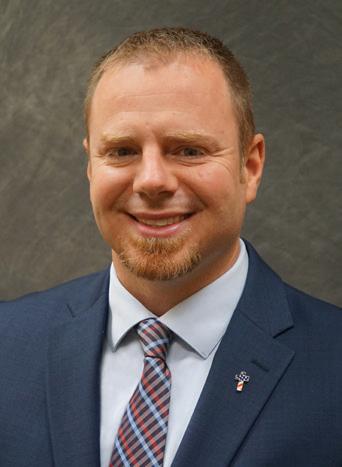
Escambia River Electric Cooperative held its 86th annual meeting on April 26 at Wallace Lake K-8 School. The event brought together members and their families for a morning filled with community connection, entertainment and cooperative pride.
The event began with member registration and voting, followed by the annual business meeting, where meeting leaders shared updates on the cooperative’s financial health, ongoing projects and goals.
PowerSouth CEO Gary Smith highlighted system improvements, recent storm response efforts, and the co-op’s continued commitment to provide reliable and affordable electric service.
A highlight of the day was awarding four scholarships to outstanding high school seniors, recognizing their achievements and supporting their educational journeys.
Wallace Lake K-8 School’s band and choir provided entertainment, adding a lively and local touch to the event. Children enjoyed a magic show,


children and parents.
Co-op staff awarded door prizes throughout the day, and members appreciated the opportunity to participate in the cooperative’s democratic process while enjoying time with neighbors and family.
EREC thanks all members who attended and











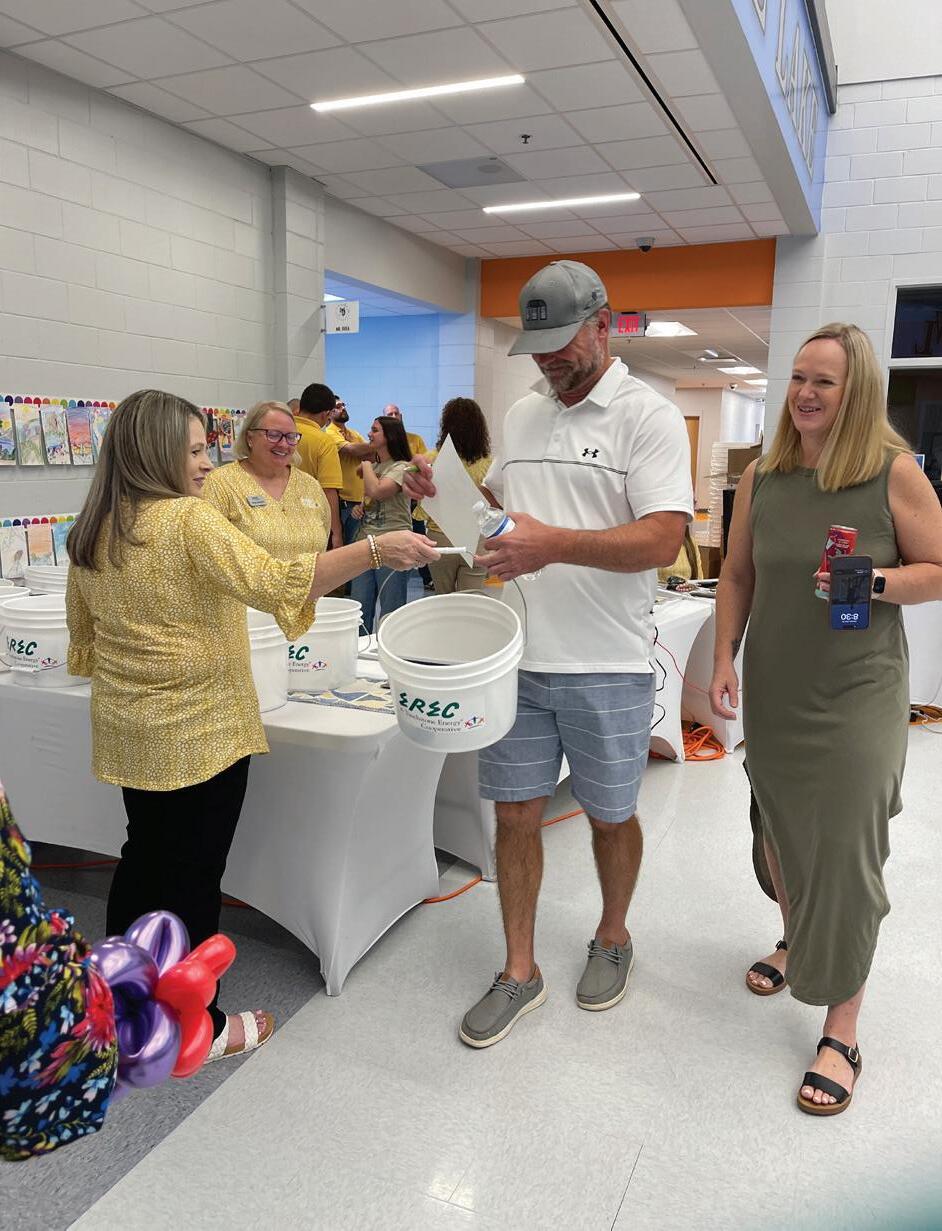
TOP ROW FROM LEFT: The Wallace Lake band performs. Dr. Gee Balloons and Magic provided entertainment. Children sat as still as possible for face paintings by Just Imagine Designs. Members took time before the meeting
BOTTOM ROW FROM LEFT: The Conexon vendor speaks with a member. Door prizes were awarded throughout the day. The grand prize winner received a $500 bill credit. Members receive registration gifts. Mr. Pig pays a special visit. PHOTOS BY CORTNEY OWENS



ESCAMBIA COUNTY:
Sam Walker: 305
Gary Wiggins: 298
SANTA ROSA COUNTY:
Rick Hunsucker: 199
Dale Westmoreland: 268
James Rowland: 158
Certified by Phyllis Crews, election official.

Escambia River Electric Cooperative hosted its second Lineman Camp in May, giving 19 high school juniors and seniors a hands-on experience of the electric utility industry.
Students spent the day working alongside EREC lineworkers, learning a small portion of what it takes to keep power flowing every day. From climbing poles to exploring the tools and safety gear lineworkers use, students were given a behind-the-scenes look into the challenging, yet rewarding, career of linework.
The lineworkers’ passion for their work was evident as they demonstrated skills, shared personal stories and answered questions. For many students, the camp opened their eyes to new career possibilities and gave them a greater appreciation for the people who keep the lights on.
EREC is proud to invest in youth education and workforce development through programs like the Lineman Camp, and it looks forward to continuing this tradition in the years to come.




No one knows electrical safety better than the experts who practice it every single day. Escambia River Electric Cooperative encourages you to to following these during- and after-storm tips to keep you and your family safe.
Avoid wires and water. When lightning strikes a home during a storm, the electrical charge can surge through pipes and utility wires. That means you can get zapped if you’re touching water or any device that’s plugged in, whether it’s a landline phone or toaster.
Skip the makeshift shelter. During a storm, it’s tempting to take cover under a gazebo or in a golf cart, but in open-sided structures with no conductors to channel strikes, a lightning bolt’s path of least resistance to the ground could be you. On top of that, these structures raise your risk of a lightning strike because of their height. Keep moving toward suitable shelter.
Take special care with portable generators. Generators can
provide a good source of power. However, they can be deadly if they are improperly installed or operated. Do not connect generators directly to household wiring. Power from generators can back-feed power lines and electrocute anyone encountering them, including cooperative lineworkers making repairs. It’s best to hire a qualified, licensed electrician to install your generator and ensure it meets electrical codes.
Avoid flooded areas. Stay away from downed power lines and avoid walking through flooded areas. Live power lines could be submerged. Immediately report any downed lines you see to EREC by calling 850-675-4521.
Never use electrical equipment that is wet. Outdoor electrical equipment could be dangerous after a summer storm. Water can damage electrical equipment and parts, posing a shock or fire hazard. n







By Les O’Dell
Livestock production in Florida is as diverse as the farmers, ranchers, shepherds and homesteaders who raise agricultural animals. From large commercial cattle and swine operations to families with a few rabbit hutches and a flock of chickens, the state boasts a wide range of livestock producers, all with their own reasons for raising the breeds they do.
For some Florida agriculturalists, one reason is conservation. These breeders choose less common varieties of animals for their farms and homesteads.
Known as heritage breeds, these traditional livestock breeds are a throwback to a time before industrial agriculture became a mainstream practice. According to The Livestock Conservancy, a North Carolina-based not-for-profit organization

working to promote and protect these animals, the breeds were carefully selected and bred over time to develop traits that made them well adapted to the local environment. They thrive under farming practices and cultural conditions that are very different from some found in modern agriculture.
Because of unique characteristics— such as slower rates of weight gain— these breeds fell out of favor with commercial producers, pushing some to the brink of extinction. Today, The Livestock Conservancy lists more than 180 agricultural breeds across 11 species—ranging from rabbits, ducks and geese to cattle, horses and pigs—on its Conservation Priority List an annual report ranking the danger of disappearance of each breed, classified from the most serious, or Critical, down to Threatened, Watch and Recovering. Based on these rankings, conservationists work to preserve these breeds.
Take Scott and Sherry Crossman, for example. On their Stafford’s Prairie Ranch near Williston, the couple raise Florida Cracker cattle, a breed listed as “Threatened” on the CPL. Descending
from Spanish cattle brought to North America in the 1500s, it is one of the oldest breeds in the United States. How the Crossmans came to select the breed—which is heat-tolerant, resistant to parasites and diseases, and thrives on lowquality grasslands—is a story itself. When purchasing the ranch, they discovered Sherry’s great-great-grandfather had owned the property in the mid-1800s and raised hundreds of Florida Cracker cattle there. The Crossmans chose to honor the legacy and have come to love the breed.
“As we studied the history of the Cracker cattle, we recognized the uniqueness of their genetic makeup and then, of course, the need to preserve those genes,” Scott says.
Other Florida breeders understand the importance of genetic preservation. Rick Blaney and Heidi Reinhardt have what they believe to be the world’s largest herd of critically endangered Galiceno horses at their Galicenos of Suwannee Horse Ranch near Live Oak. Although small in size compared to many equine breeds— Galicenos mature at 12-13.2 hands, or 48-54 inches—they are an intelligent and gentle breed, fully capable of carrying an

adult human with a smooth gait that is easy on the rider.
“These horses are unique,” Rick says. “They are descendants of the first horses brought to the new world by Columbus and Cortez. Plus, I have a long history of working with endangered species, and when I found out how endangered this breed was, it was a natural transition to focus on saving the genetics of this breed. That really caught my attention.”
Heidi says she loves the breed for other reasons.
“My adoration for this breed comes from their size, stature, stamina, personalities, varieties of solid colors and the ease with which I can train them,” she says.
The pair says their role goes beyond simply raising the horses.
“Our mission is saving the breed and educating people about them. This is such an important breed in history that people need to know about them,” Rick adds.
Paul Bradshaw, owner of Greenfire Farms in Midway, sells rare and vanishing varieties of chickens from around the world. His efforts have been responsible for doubling the number of chicken breeds in the United States, including several Conservation Priority List varieties, including Crevecouer (Watch), Icelandic (Threatened) and Spitzhauben (Watch).
He reports that Greenfire Farms has more than 1,000 birds representing more than four dozen breeds.
“Our basic thesis is that chickens are a vital source of animal protein globally, both with eggs and meat, but commercially, it is a very genetically limited and vulnerable population,” Paul says, adding that keeping living birds is key. “Unlike a seed bank or with mammals where you can freeze genetics, you can’t do that with chicken. You must have live chickens, so essentially, we have the biggest chicken gene bank in the world. If we don’t do that, we paint ourselves into a corner.”
Securing biodiversity and genetic resources are important for protecting these breeds, explains Alison Martin, program director for The Livestock Conservancy. However, many producers choose heritage animals because they want to make a difference.
“None of us has a crystal ball to see what the future of agriculture will look like,” she says. “This is about keeping these breeds around as a genetic reservoir.” She adds that these animals are key to food security. “If we didn’t have this diversity, eventually, we would narrow our food system down to where it wasn’t sustainable. There would be no backup.”

Paul puts it another way.
“The level of vulnerability we have when we have bred our animals into this genetic cul-de-sac becomes hard to escape,” he says. “This is one of those rare instances where an individual can really move the needle just by keeping a flock or herd. It’s a real opportunity for individuals to make a difference in their own backyard.”
The efforts are paying off. Since first establishing the Conservation Priority List 37 years ago, The Livestock Conservancy has not lost a breed to extinction. In fact, in the past dozen years, 12 breeds have “graduated” off the CPL, meaning those animal populations no longer need continual monitoring. In 2024, two breeds—Southdown sheep and Hereford pigs—graduated from the list, and 15 breeds were reclassified within the CPL’s four tiers, most in a positive direction.
For farmers, educators and conservationists, raising and promoting heritage breeds and their products is a labor of love.
More information about these animals and the Conservation Priority List can be found at livestockconservancy.org.










By Theresa Sterling














A framed photo from the ’80s shows the sun glinting off Thomas DeCarr Hosford’s dark blonde hair as he sits on the edge of an outdoor pool, supporting a boy who is learning to swim.
Forty years and two knee replacements later, Thomas, who goes by Dickie, is still youthful and agile. He still teaches swimming and coaches the sport. He estimates he’s taught thousands of North Florida children to swim since those first lessons.
“With all of Florida’s shoreline, kids here should all know how to swim,” Dickie says. “If you fall in the water and you don’t know how to swim, you drown. Swimming will save your life. I don’t know of another sport as important or as lifesaving.”
The family’s Hosford Swim School is a Tallahassee institution. It began as a side gig while Dickie worked as a lifeguard and later as a pool manager at Capital City Country Club. Over time, it grew into a gold star swim lesson program open to all of Florida’s Big Bend families.


He later served in Leon County schools for 37 years as a physical education teacher, swim coach and athletic director, all while teaching countless children, starting at age 2, how to swim.
Dickie maintained the pool for the 110-year-old Capital City Country Club, where his father once served as president. Eventually, Dickie’s sons served as lifeguards. His son, Malcolm, 43, now maintains the pool. After working alongside his father for years, Malcolm learned to patch, seal, paint and preserve the pool during dry months. It is an annual labor of love and duty—a new pool would cost the club millions of dollars. It cost $46,000 to build in 1958.
After teaching at the swim school for many years and watching his father coordinate the program the old-fashioned way, Malcolm took over in 2009 while he was studying at Florida State. Now, he runs Hosford Swim School.
“Malcolm really took it to a new level,” Dickie says. “All those years he watched me doing hand mailers, opening stacks of mail with paper registrations and tracking check payments, writing out schedules by hand. He really thought he could grow the school, streamline things and bring us into the 21st century, with social media and all. He really has done that.”

While a member of Florida State University’s swim team, Dickie earned a reputation not only as a competitive athlete but also as someone with a knack for working in the water with children.
Malcolm extended his teaching hours, and his wife, Lena, joined the team in 2013. She manages the swim school’s social media accounts, developed its logo and created a website, which crashed as soon as online registration went live due to the overwhelming volume of sign-ups.



Every season, Hosford Swim School instructors teach 2,000 people. Considering all the years Dickie ran the school on his own, easily 10 or 20 times that number of North Florida children have learned to swim through the Hosford program. They work with young children, teens and college students and have given specific lessons to adults planning to dive for shells on vacation. The waitlist is months long.
Malcolm’s bona fides include high school and NCAA AllAmerican titles, a swimming scholarship to Auburn University and a place on the Florida State University swim team. He was an Olympic Trial qualifier—twice—and coached Georgia’s Thomas University swim team for a few years. When he needed an assistant coach there, he tapped Dickie to join him. His first memory of swimming was with his mom, who gave swimming lessons at her mother’s school, Sutton’s Educational Day Care, in Tallahassee.
Malcolm balances his elite competitor side with a father’s gentle touch while working with young swimmers. He guides goggled heads through side-to-side breathing motions, and just as Dickie used age-appropriate language with the kids—saying “Be a chipmunk” instead of “Hold your breath,” for example, Malcolm does the same.
Leach Student Recreation Center at Florida State University.
Dickie says the way Malcolm works with children comes naturally to him. Malcolm admits he loves kids and especially likes working with the scared ones because he can see their progress.
“I have always been around kids,” he says. “My mom ran a home day care, and my grandmother had the day care in Tallahassee for years. I learned a lot from my grandma because she had the tough love approach. With swimming, you have to bring that to the table because it’s a lifesaving skill before anything else. You have to not let a kid cry their way out of it or let a parent pull them out because they’re crying. It’s just too important.”
These days, Hosford Swim School brings lessons and water safety skills to families in Leon County homes, country clubs and at Leach Recreation Center on the campus of Florida State University in Tallahassee.
Spencer Dalton, a mom of three whose youngest daughter, Reese, 5, is a student at Leach Center, sent her two older children to Hosford Swim School. Spencer, a native Floridian who grew up on the Atlantic Coast, says the peace of mind she and her husband feel, knowing her children learned to swim with Hosford, is invaluable.
“We are a water family,” Spencer says. “We are on our boat on the Gulf, Lake Talquin and the Apalachicola River. It’s important to us that our kids are confident around water, even water that isn’t a pool with steps—water out in nature.”
Peninsular Florida’s general coastline stretches 1,350 miles, and the tidal shoreline—exposed shore boundaries that fluctuate depending on tides—totals 2,276 miles. According to the Centers for Disease Control and Prevention, the state ranked fourth in the United States for unintentional drowning deaths among all ages in 2021, and from 2019 to 2021 ranked the highest in the United States for unintentional drownings among children ages 1 to 4.
Roberta Cooper, Florida native and mom to 4-year-old Savannah, says basic swimming skills and comfort around water are essential for all families with children, whether or not they live near the coast.
“We don’t have a pool at home, but we travel and stay at hotels with pools,” Roberta says. “This is important just for basic safety.”
Austin Hosford, 38, the youngest of Dickie’s four sons, is a Jefferson County commissioner in rural Monticello, just east of Tallahassee, where he lives with his wife, Jessi, and their two children. Austin was a lifeguard at Capital City Country Club at age 16 and taught at the swim school, too.
Holding their 2-year-old son, Barrett, by the pool in their backyard, Jessi wondered aloud if the toddler is too young to start swim lessons this summer. Dickie gave professional advice and a strong grandfatherly opinion.
“With a pool in your backyard,” he said, “this summer he has to either learn respect for the pool or learn how to swim.”
What Dickie is most proud of, he says, is teaching so many kids the lifesaving skill of swimming, of opening doors for them to all the other water sports they may want to do. They are, after all, Floridians.
Learn more about Hosford Swim School at hosfordswimschool.org.

Drownings are one of the leading causes of child deaths in the state, according to the Florida Department of Children and Families. The agency offers key tips for keeping children safe in and near the water.

Never go near the water without an adult. It’s important for young children to know the fun can’t begin until a “water watcher” is present. Drowning can happen quickly and quietly, so someone keeping an eye on swimmers is a necessity. Make sure your child knows never to go near the water alone and always to have a swimming partner. Install barriers around your pool or hot tub, and remove any pool toys that could attract children to the water.
Wear a life jacket. Always wear a life jacket while in a boat, raft, inner tube or on a dock. If a child cannot swim or is an inexperienced swimmer, use a life jacket while in the water. Fit the jacket to keep the child’s head and face above water. Remember, life jackets only work when they are worn, so make sure your children get in the routine of putting one on every time they get near the water. Water wings and inflatable toys don’t provide the same support as a U.S. Coast Guardapproved life jacket.



Learn to swim. Swimming lessons can reduce drowning incidents, which is why the American Academy of Pediatrics recommends children 4 and older learn to swim. Even if your child has taken swimming lessons, never assume their risk of drowning is over. To find swimming lessons in your area, contact your area YMCA, American Red Cross, American Heart Association, city facilities or a local swim school














Easy Pepperoni Pizza Quesadillas
2 8-inch flour tortillas
2 tablespoons tomato sauce (may substitute spaghetti, pizza or marinara sauce)
10 to 12 slices pepperoni


6 to 8 tablespoons shredded mozzarella cheese
Butter
Additional tomato sauce
Spread tomato sauce evenly over entire tortilla in a thin layer. Add pepperoni, covering half of each tortilla.
Sprinkle the pepperoni with a layer of cheese. Fold over the top of the tortilla. Melt a bit of butter in a skillet. Place two quesadillas in the skillet. Cook 2 to 3 minutes over medium heat until lightly browned.



While the first side of the quesadilla is cooking, lightly butter the other side of each tortilla. Flip over the tortillas, and cook until the second side is browned. Remove the quesadillas from the pan. Let rest for a few minutes, then slice each tortilla into quarters or thirds. Serve with warm tomato sauce for dipping.

8 ounces cream cheese, softened
½ cup sour cream
¼ cup picante sauce
2 tablespoons taco seasoning
Dash garlic powder
4.5-ounce can chopped olives, drained
4-ounce can chopped green chiles
1 cup finely shredded cheddar cheese
½ cup thinly sliced green onions
8 10-inch flour tortillas, warmed Salsa
In a small bowl, beat together cream cheese, sour cream, picante sauce, taco seasoning and garlic powder until smooth. Stir in olives, chiles, cheese and onions. Spread about ½ cup on each tortilla. Roll up jelly-roll style.
Cover. Refrigerate for at least 2 hours. Slice into 1-inch pieces before serving with salsa.
Taco Lasagna Recipe
2 tablespoons olive oil, divided
1 pound lean ground beef
1 medium yellow onion, diced
1 medium red bell pepper, cored, seeded and diced
2 cloves garlic, minced
15-ounce can black beans, drained and rinsed
1 tablespoon chili powder
2 teaspoons ground cumin
1 teaspoon dried oregano
1 teaspoon kosher salt
¼ teaspoon freshly ground black pepper
16-ounce jar salsa, divided
12 8-inch corn or flour tortillas, divided
16 ounces sour cream, divided
16 ounces shredded Mexican cheese blend, divided
Heat oven to 350 F. Arrange a rack in the middle of the oven. Heat 1 tablespoon of oil in a large, high-sided skillet over medium-high heat until shimmering. Add ground beef. Cook, breaking up the meat with a wooden spoon, until browned and cooked through, 6 to 8 minutes. Using a slotted spoon, transfer the meat to a plate. Pour off any fat from the skillet.
Reduce heat to medium. Add the remaining olive oil. Heat until shimmering. Add the onion, bell pepper and garlic. Cook, stirring occasionally, until softened, about 5 minutes. Return the beef and any juices to the skillet. Add black beans, and stir to combine. Add chili powder, cumin, oregano, salt and black pepper. Stir to combine. Cook for 2 minutes.
Remove the skillet from the heat. Pour ¼ cup salsa into a 9-by-13 baking dish. Pour the remaining salsa into the skillet. Stir to combine.
To assemble the lasagna, spread out the salsa in the baking dish into a thin layer. Arrange four tortillas in a single layer on top of the salsa, overlapping them as needed. Dollop and spread ⅔ cup of the sour cream. Spoon half of the meat mixture over the sour cream. Spread in an even layer. Sprinkle with 1⅓ cups of cheese.
Repeat layering the following: four tortillas, ⅔ cup sour cream, the remaining meat mixture and 1⅓ cups shredded cheese. Top with the remaining four tortillas and ⅔ cup sour cream. Sprinkle with the remaining 1⅓ cups cheese.
Bake, uncovered, until the cheese is melted and lightly browned, about 30 minutes. Cool for 15 minutes before serving.
Sour
3 tablespoons butter
3 tablespoons all-purpose flour
2 cups chicken broth
1½ teaspoons chili powder
¼ teaspoon oregano
¾ teaspoon salt
¼ teaspoon black pepper
1 pound boneless, skinless chicken breasts, diced
1 cup sour cream
6 to 7 regular-sized flour tortillas, cut into bitesized pieces
7.5 ounces black beans, drained
14.5-ounce can diced tomatoes, drained
1 cup shredded cheese
In a large skillet, heat butter until melted. Stir in flour, and cook for 1 minute. Whisk in chicken broth. Stir until sauce is smooth and thickened, about 2 to 3 minutes. Stir chili powder, oregano, salt and pepper into the sauce.
Add chicken breasts to the pan. Bring to a simmer, then reduce heat to low. Cover and cook for about 15 minutes, until chicken is cooked through. Remove chicken from the pan, and shred into bite-sized pieces.
Stir sour cream into the sauce. Return the chicken to the skillet. Add tortilla pieces, black beans and tomatoes. Stir until combined, then top with shredded cheese.
Cover skillet and cook until bubbly and the cheese is melted, about 5 to 8 minutes.
1¼ pounds lean ground beef
¼ cup finely chopped onion
1¼ cups salsa
2 tablespoons taco seasoning
½ cup water
2 15-ounce cans pinto beans, rinsed and drained
2 cups shredded cheddar cheese
12 8-inch flour tortillas, warmed
In a large skillet, cook beef and onion over medium heat until meat is no longer pink, about 5 to 7 minutes, breaking meat into crumbles. Drain. Stir in salsa and taco seasoning. Bring to a boil. Reduce heat. Simmer, uncovered, for 2 to 3 minutes. Transfer to a large bowl, then set aside.
In a food processor, combine water and beans. Cover. Process until almost smooth. Add to beef, and stir in cheese.
Spoon ½ cup beef mixture down the center of each tortilla. Fold ends and sides over filling. Roll up. Wrap each burrito in waxed paper and foil. Freeze for up to 1 month.
To heat frozen burritos: Remove foil and waxed paper. Place one burrito on a microwave-safe plate. Microwave on high until a thermometer reads 165 F, about 3 minutes, turning burrito over once. Let stand for 20 seconds.
By Dave LaBelle
There are annual events—such as birthdays, anniversaries and holidays—many of us are determined to make pictures of.
One of the annual events I am often called on to photograph is fireworks during the Fourth of July. Here is where I confess, even though I have photographed fireworks for more than a half a century, I never seem to capture the picture I want.
Oh, I have made some acceptable pictures through the years but not one that I felt expressed what I saw and felt.
I surveyed the grounds early where the fireworks were to be launched this past year, seeking every possible angle.
Some cities have hilltops or big rivers running through them, like Pittsburgh or Portland, Oregon. But Dyersville, Iowa, is flat with few bumps we might dare to call hills.
Finally, I decided on a low, grassy spot that afforded a relatively clean, uncluttered view of the aerial bursts. However, as parking spaces grew thin, vehicles lunged forward, parking on the grassy spot I had

chosen. Camera and tripod in hand, I had to move or get run over.
Just as I was about to seek another last-minute vantage point, a couple of children put down a blanket between two vehicles and sat waiting for the show.
Hmmm?
If I could get low enough, they might make a good foreground, their shapes against
a lit-up sky.
I moved up slowly and stealthily behind them and lay on the ground to see if I could get the camera low enough— off the tripod—to see if I had enough sky to see and capture fireworks once they began.
At one point—still 30 minutes before the show—I had to explain to their father, watching me suspiciously, the photo I was hoping to capture.
Determine to make a beautiful photograph that captures the spirit of celebration meant by filling the sky with beautiful explosions of color and design. Scout areas and choose the spot first. Then consider using a tripod and slower shutter speed. To create depth and context, foreground is key. Above all, experiment with exposure. Each burst is often a different color and intensity.
Email your best image (just one) with caption information, including an explanation of how it affects you, to gph@pioneer.coop. We may share submissions on our website and social media channels.
As most of you who have attempted to photograph fireworks know, there is a lot of luck involved. That acknowledged, the old maxim, “Luck is where opportunity meets preparation,” was on my side this evening.
After a handful of lowbursting blasts, finally a reddishpink explosion filled the sky low enough to wash over and even reflect on the parked vehicles. n

at bridgesandangels.wordpress.com.
If you suspect you’re dealing with a utility scam, it’s crucial to slow down and take your time before taking any action.
Scammers will often pressure you to make quick decisions or immediate payments. Instead, take the time to verify the legitimacy of the communication by contacting your utility directly.
Use a phone number from a reliable source, such as your bill or the utility’s website. Taking this simple step can help protect you from falling victim to utility scams.
Source: Utilities United Against Scams

The Florida Panhandle offers a beautiful setting and many diverse fishing opportunities. A top angling destination, St. Andrew Bay covers approximately 25,000 acres near Panama City Beach.
“Probably one of the biggest draws to this area is that we have so many different fishing options,” says Justin Leake with Panama City Inshore and host of “Chasin’ the Sun” on the Discovery Channel.
“Summer is probably the most versatile time to fish this area.”
The very salty and clear sparkling waters provide excellent sight-fishing for redfish and other species. People can also catch speckled trout, flounder and other saltwater fish. Anglers without boats wade the pristine beaches.
“In June, we catch redfish around the bridges and passes with a variety of artificials,” Justin says. “We catch bull reds with live bait. The early-morning topwater bite is really good for speckled trout and redfish. After the redfish action slacks off, we move out deeper and throw jigs for trout.”
Florida excels at tarpon action. The Panama City Beach area once held the state record for tarpon and still delivers some giants exceeding 200 pounds. In the summer, tarpon chase baitfish in shallow water close to the beaches.
“My No. 1 go-to summer activity is tarpon fishing,” Justin says. “The tarpon are mostly migrating along the beaches
where we sight fish them with live bait or swimbaits. Their backs are relatively dark, so they really stand out in that emerald green clear water.”
Anglers watch for tarpon to roll on the surface and then toss live baits or lures to them. Silver kings bite just about anything that resembles a baitfish. Many people fish for tarpon with fly tackle.
“Tarpon will eat anything that looks like an easy meal,” Justin says.
People can find mangrove snapper and sheepshead around hard structures. For mangroves, use live shrimp or baitfish. For fast action, fish for bluefish and Spanish mackerel around grass flats near the pass. These toothy predators will attack anything shiny that mimics a baitfish.
Larger boats head offshore to fish for red snapper, grouper and other fish during the summer. Depending on the location and water depth, anglers might also catch king mackerel, cobia, dolphin—also called mahi—wahoo, tuna, sailfish or blue marlin.
“Offshore, we go for red snapper and king mackerel in June,” Justin says. “We catch snapper from 60 to 200 feet of water. Any live or dead bait will work. King mackerel hang around the buoys and reefs looking for bait concentrations.”
Those fishing with a Florida licensed charter captain do not need a state fishing license. People can enjoy other recreational activities commonly associated with beach
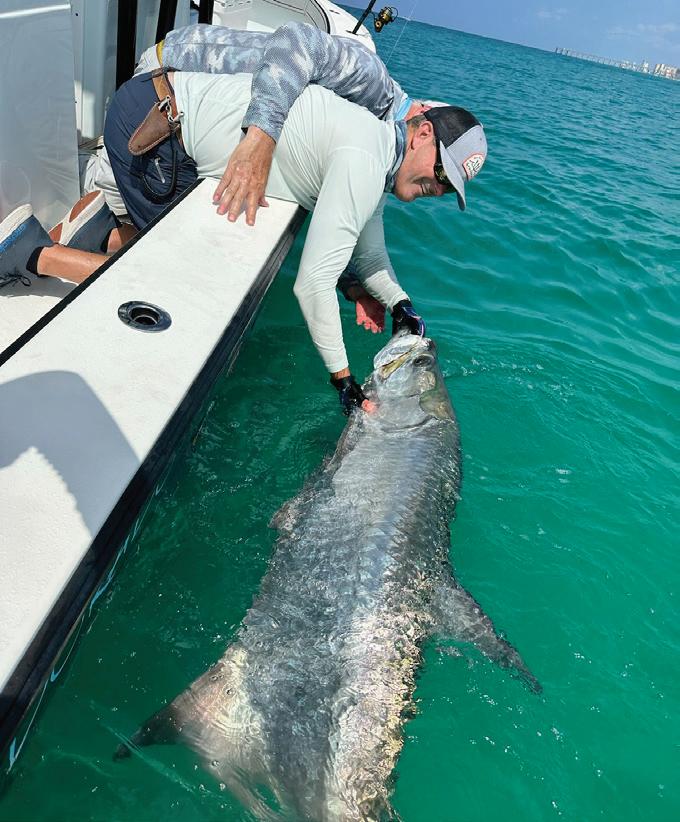
PHOTOS COURTESY OF JUSTIN LEAKE, PANAMA CITY
communities. For seafood, try the Grand Marlin or Capt. Anderson’s in Panama City Beach. I recommend staying at Sheraton Panama City Beach Golf & Spa Resort. n
For more information, visit destinationpanamacity.com or visitpanamacitybeach.com. For more about Panama City Inshore Fishing, call 850-258-7780 or visit panamacityinshore.com.

John N. Felsher is a freelance writer, broadcaster, photographer and editor. He’s written more than 3,500 articles on a wide variety of outdoor topics. Contact him at j.felsher@hotmail.com or through Facebook.






































All ages can find something new and exciting around every corner of the state. Filled with rich history, abundant natural beauty and diverse events all year, Florida has something fun for everyone.
June 1-20
Summer Solstice Celebration
Join us at Mallory Square for 20 evenings this June as we celebrate the summer solstice. Participants consist of arts and crafts exhibitors, psychics, street performers, food carts, and thousands of tourists who visit this art show. Each night, one hour before sunset, locals and tourists flock to the water’s edge to experience a multicultural happening and watch the sun sink into the Gulf. www.sunsetcelebration.org; 305-396-7046


June 3
Nature Through The Looking Glass
Join a ranger at the Gator Lake Overlook to try and spot American alligators, bald eagles, various wading birds and other species native to the state of Florida. Spotting scopes and binoculars are provided. Parking for the Gator Lake overlook is on the main park loop. bit.ly/43meDnd; 850-245-2157
June 5
Truman Waterfront Farmers Market
Shop with a view 2-7 p.m. every Thursday at the Truman Waterfront Farmers Market on the harbor by the U.S. Coast Guard Cutter Ingham Maritime Museum. Find food, including ready-to-eat items, fresh Florida produce and other grocery items, alongside gifts, home decor, art and more. keysartisanmarket.com; 305-731-3385

June 7
Palafox Market
Find one-of-a-kind, precious and offbeat items, and delicious goods, originating from on-site vendors. Join us from 9 a.m. to 2 p.m. every Saturday, rain or shine, for farm-fresh produce, plants, flowers, baked goods, works of art, fresh tea and coffee, food and spices, hand-blown glass, and ceramics. downtownpensacola.com/palafox/palafox-market; 850-380-8196

June 7
Into the Woods: Artist’s and Farmer’s Marketplace Neighbors, friends and family are invited to the inaugural Artist’s and Farmer’s Marketplace. This 6-acre property is a thriving hub of honeybees, vegetables and pottery, making it the perfect destination for artisans, farmers, makers and bakers. Join us in exploring exceptional products from talented creators while enjoying the peaceful surroundings. 850-679-4750
June 7
History Tour
Join in a guided tour of Camp Helen State Park. Staff share park history from the Hicks family building to the colorful history of Avondale Mills using the property as its employee vacation retreat. Gather at 10 a.m. at the visitors center/park office and dress appropriately for the weather. Park admission is $4 per vehicle, $2 per pedestrian or bicycle in the honor box at the entrance or via the QR code on the entry sign. www.floridastateparks.org/events/history-tour-35; 850-245-2157


June 5
16th Annual UF/IFAS Range
Cattle REC Youth Field Day
The goal of this event is to excite students about agriculture and science and foster a love of learning. Students 8 to 18 years old earn a Youth Beef Quality Assurance Certification. This year’s classes are Biosecurity: Lowering the Exposure; Nutrition and Body Condition Scoring; Newborn Calf Health Management; Low-Stress Cattle Handling; and Best Practices: Using Injectables. General registration is open until June 3 for $25.
rcrec-2025-yfd.eventbrite.com; 863-735-1001






June 7
Centennial/Sesquicentennial Festival
Join us 9 a.m. to 3 p.m. for a fun, family-friendly event in honor of Wewahitchka’s 150th and Gulf County’s 100th birthdays. There are food vendors, arts and crafts booths, children’s activities, live music, and library exhibits and speakers. Special events include a Wewa settlers costume contest and an antique car show. Sponsored by the Friends of the Wewahitchka Library, the Wewahitchka Historical Society and the City of Wewahitchka, the event is free and open to the public. www.facebook.com/profile.php?id=61572259151675; 850-639-2419
June 14


College of the Florida Keys Swim Around Key West Embark on an adventurous competitive swim—a 12.5-mile loop around the island. The pristine waters around Key West give swimmers great views of the land and underwater life. Compete in categories, such as solo swimmer, solo swimmers with fins, solo swimmers using a mermaid tail or a monofin, or gather your friends and compete in the relay category of two-, three-, four-, five- or six-person teams. Not interested in the full island swim? Try some of the other races offered: the 6.1-, 2- or 1-mile swims, or an 800-yard swim. Swims begin and end at Higgs Beach, 1000 Atlantic Blvd. swimaroundkeywest.org; 305-809-3562
June 19
Juneteenth at Five Sisters’ Blues Cafe Juneteenth is the oldest nationally celebrated commemoration of the ending of slavery in the United States. On June 19, 1865, Union soldiers landed in Galveston, Texas, with news that the war had ended and the enslaved were free. Juneteenth meals feature foods connecting cooking traditions of the African diaspora. African American pit masters display their barbecue alongside other dishes, such as greens and black-eyed peas, that represented prosperity and good fortune. Summer fruits and flowers in shades of red are a special highlight during Juneteenth. It is with this in mind that Five Sisters’ chef Josh Rich is once again offering a selection of Juneteenth adaptations to honor African American contributions to America’s culinary tradition and celebrating Juneteenth. fivesistersbluescafe.com; 850-912-4856
June 28
Generations of Strength Street Fair and Dance Party




This joyous event in the 700 to 1,000 blocks of Duval Street is the heart of Pride festivities, showcasing a mix of performances, eclectic vendors and diverse community spirit. With more than 50 vendors, you’ll discover an array of unique crafts, delicious food and informative booths. The party doesn’t stop there. Join the dance floor for live performances. Whether you’re exploring the fair or dancing with friends, this event promises an unforgettable experience of unity and celebration. All are welcome at this family-friendly event.
gaykeywestfl.com/pride; 800-535-7797

June 13-14
Watermelon Festival
Get ready to relive the sweetest moments of the past while making juicy new memories. We’re celebrating decades of watermelon magic—from groovy events to nostalgic festival traditions that have stood the test of time. Whether you’re rocking your best vintage vibes or embracing the modern melon moment, join us as we honor the generations who have made this festival a summertime staple. It’s time to taste the tradition, dance through the decades and celebrate your Watermelon Era. The festival is 3-9 p.m. Friday and 9 a.m. to 3 p.m. Saturday. www.monticellowatermelonfestival.com; 850-997-5552

Want to share a family-friendly event with the readers of Florida Currents? Head online and enter the details at tinyurl.com/FloridaCurrents or use the QR code for easy access. Make sure to submit the item at least 60 days before the event (due to press deadline). If you own rights to a print-quality photo promoting your event, include it with photo credit information.




When it comes to managing pests in the garden, pesticides often seem like a quick and effective solution. However, overreliance on them can lead to pesticide resistance and potentially harm increasingly fragile ecosystems. That’s where natural enemies can come into play. Certain insects act as nature’s pest control.
Predators such as lacewings, lady beetles, minute pirate bugs, big-eyed bugs, syrphid flies and praying mantis, alongside parasitoids such as tachinid flies and parasitoid wasps, help maintain balance in the landscape by feeding on pests or laying their eggs inside or on them.
Supporting these beneficial insects ensures we rely less on chemicals and more on nature’s own pest control mechanisms. One of the best ways to support these garden allies is by creating an environment rich in plant diversity.
In regions such as Central Florida where year-round blooms are possible, maintaining a continuous supply of flowering plants ensures beneficial insects can thrive throughout the year.
A variety of culinary herbs that help predators can be incorporated into the landscape, including dill, cilantro, spearmint, peppermint, parsley, thyme, fennel, basil, lemon balm, catnip and horsemint/bee balm.
Wildflowers and ornamentals provide nectar and pollen, key resources for adult foraging insects. That includes echinacea, yarrow, zinnia, calendula, goldenrod, chamomile, rouge plant, coreopsis, porterweed, gaillardia, liatris, cosmos, sweet alyssum, rattelsnake master, rudbeckia and Stokes’ aster.
Woody perennials and trees should not be overlooked as they offer shelter and food. Among them are oak species, holly species, Simpson’s stopper, Chickasaw plum, crape myrtle, button bush, Walter’s viburnum and fire bush.
Native bunch grasses are also essential, offering refuge for reproductive insects to lay their eggs and raise their young.

Some common native species of bunch grasses include Elliot’s love, purple love, Florida gama, lopsided indian, muhly and Fakahatchee.
Minimizing disturbances is equally important for fostering natural enemies in the garden. Before reaching for a pesticide, start by scouting your garden and identifying the pest.
Florida alone is home to more than 12,500 insect species. Of this incredible diversity of species, less than 3% are actually considered pests, so proper identification is key. Simple hand removal or physical methods are often effective for many insect pests.
If chemical intervention becomes necessary, choose nontoxic or less-toxic options, such as microbial insecticides, horticultural oils and soaps. Avoid applying pesticides when plants are in bloom, and

opt for targeted chemistries and mindful applications as a last resort.
Finally, rethinking how landscapes are managed can make a big difference. Reducing mowing, tilling and debris removal allows beneficial insects—especially those that live in leaf litter or hollow plant stems—to establish stable populations.
A slightly wilder, less manicured garden can be a haven for these natural enemies, giving them the time and space to do their part in maintaining a healthy, balanced ecosystem.
By embracing this approach, we can cultivate a garden that supports beneficial insects and leads to more sustainable pest management overall.
Find native and Florida-Friendly plants in your area by visiting Florida Association of Native Nurseries and BetRock’s Plant Finder.
Dr. Heather Kalaman serves as the Florida-Friendly landscaping horticulture agent for UF/IFAS Extension Orange County. She is a graduate of the UF Doctor of Plant Medicine Program and has a master’s degree in environmental horticulture, where her research focused on pollinator-plant interactions. Her passions and programing are focused on sustainable landscaping practices.
When you save energy at home, you’re helping your family save money and protecting the environment.
Read the energy-saving tips below, then nd and circle the bolded words in the puzzle.
• Close blinds and curtains on hot, sunny days to block additional heat from entering your home.
• Turn o lights and electronics, such as TVs and stereos, when you leave a room.
• Turn o the water while you brush your teeth.
• Only clean full loads of dishes when you run the dishwasher
• Cooking with smaller appliances like slow cookers and toaster ovens use less energy than larger appliances.
• Unplug phone chargers when they’re not in use—they consume energy even when they aren’t charging devices.
Oliverio’s Italian Bake Shop
304-677-1629
Check them out on Facebook.
Located in the heart of Jay, Oliverio’s Italian Bake Shop is a small, family-owned bakery with deep Italian roots and a passion for tradition. Known for its fresh, homemade breads, cookies, pasta and all things delicious, the shop brings Old World flavor to the local community. Every item is made from scratch using time-honored recipes passed down through generations. At Oliverio’s, it’s not just about food—it’s about sharing the love of Italian heritage, one bite at a time.
Wiggins Sod Farm, LLC
850-292-1327; wigginssodfarm@gmail.com
Walnut Hill, Florida
Check them out on Facebook.
Wiggins Sod Farm in Walnut Hill is your trusted source for locally grown, farm-fresh, premium, green grasses. The farm produces and delivers and deliver high-quality sod to help homeowners, businesses and landscapers create beautiful outdoor spaces. Whether you’re starting fresh or improving your yard, Wiggins Sod Farm is professional, dependable, affordable and here to help you every step of the way. Let Wiggins help you grow the lawn you’ll love to come home to.


Businesses hold small, rural communities together. Let’s keep local businesses thriving. From manufacturing and industrial to service and retail, businesses provide jobs to keep young people in the area and improve our quality of life. If your business is in Escambia River Electric Cooperative’s service territory, and you want to have it spotlighted here, submit information to Cortney Owens at cowens@erec.com.
N’ That Submit an ad by the first of the month to see it here.
For Sale Trains/Layout HO Scale. Most parts new and many extras. Can send pictures. $2K OBO. Call 850359-1395. Leave Message.

This N’ That Guidelines To continue to provide This N’ That in every issue of Florida Currents, we ask members to adhere to the guidelines listed below when submitting an ad. If an ad does not meet
N’ That. The ad submission deadline is the first of each month and is printed in the following month.
•Members may submit one ad per issue (12 times a year)
• Ads must be 25 words or fewer.
• Ads must be typed or printed legibly in ink
•No registered businesses

Don’t take the power of electricity for granted
Electricity and water are a dangerous—potentially fatal—combination.
Swimmers and boat owners need to take precautions to make sure their time in and on the water is safe. While this might seem like common sense, boats and docks are often powered by electricity. One mistake could lead to tragedy. Consider the following points:
• There is no visible warning to electrified water. Electric current in water causes a paralysis of muscles, which can result in drowning. As little as 10 milliamps—1/50 of the amount used by a 60watt light bulb—can cause paralysis.
• If you are in or on the water and feel a tingling, the water might be electrified. Immediately get out of the water. Avoid using metal objects, such as a ladder. Alert others who are in the water to try to stay upright, tuck legs to be smaller and swim away from anything that could be energized.
• If you believe an electric shock drowning is occurring, turn off all power, throw a life ring to the person, and call 911. Do not enter the water. It could still be electrified.
• If you own a dock or pier, install ground-fault circuit interrupters, and test them monthly. Use portable UL-Marine List GFCIs when using electricity near water.
• If you own a boat that uses electricity, install equipment leakage circuit interrupters to protect swimmers from electric shock in the water around the boat. The Energy Education Council recommends all electrical installations be performed by a professional electrical contractor familiar with marine codes and standards. The organization also recommends individuals not swim around docks with electrical equipment or boats plugged into shore power. Many electrical shock drowning deaths have occurred around private docks and boats plugged into shore power while docked.
When outdoor temperatures soar, our electricity use increases. That’s because our air conditioners are running longer and more often to counteract sweltering outdoor temperatures. Factor in that we tend to use electricity at the same times—in the morning and early evenings—and that equals a lot of strain on our electric grid.
Escambia River Electric Cooperative works closely with PowerSouth, our local generation and transmission (G&T) cooperative in resource and infrastructure planning to ensure you have the power you need whenever you flip a switch. However, the electric grid is much larger than your local co-op and G&T.
In summer months, when more electricity is being used simultaneously across the country, it’s possible for electricity demand to exceed supply, especially if a prolonged heat wave occurs. If this happens, the grid operator for our region may call on consumers to reduce their energy use or initiate rolling power outages to relieve pressure on the grid. EREC will always keep you informed about situations like this.
We work proactively with our G&T to create a resilient portion of the grid and ensure electric reliability in extreme weather. Our efforts include regular system maintenance, grid modernization efforts and disaster response planning. However, it takes everyone to keep the grid reliable.
Here are a few steps you can take to relieve pressure on the grid so you, your family and neighbors can all keep your air conditioners running.
• Select the highest comfortable thermostat setting and turn it up several degrees whenever possible. Your cooling system must run longer to make up the difference between the thermostat temperature and the outdoor temperature.


















During periods of extreme heat, the demand for electricity can skyrocket, placing additional strain on the grid. By working together to lower our electricity use, we can reduce pressure on the grid.
















Pro tip: Seal air leaks around windows and exterior doors with caulk and weatherstripping. Air leaks and drafts force your cooling system to work harder than necessary.
• Run major appliances—such as dishwashers, ovens and dryers—during off-peak hours when the demand for electricity is lower.
Pro tip: Start the dishwasher before you go to bed.
• Use ceiling fans to make yourself feel a few degrees cooler. Remember, ceiling fans cool people not rooms, so turn them off in unoccupied rooms.
Pro tip: During summer months, set ceiling fan blades to rotate counterclockwise, which pushes cool air down for a windchill effect.
• Close blinds, curtains and shades during the hottest part of the day to block unwanted heat gain from sunlight.
Pro tip: Consider blackout curtains with thermal backing or reflective lining.
• Use smaller appliances—such as slow cookers, air fryers and toaster ovens—to cook.
Pro tip: Studies have shown that air fryers use about half the amount of electricity as a full-sized oven. Air fryers are smaller and use focused heat, which results in faster cooking times, less heat output and lower energy use.
As we face the challenges posed by soaring summer temperatures, understanding the impact on energy demand is crucial for maintaining a reliable power supply. By adopting energy conservation practices during periods of extreme heat you can save money on your electric bills and contribute to the resilience of the grid, keeping our community cool and connected. n


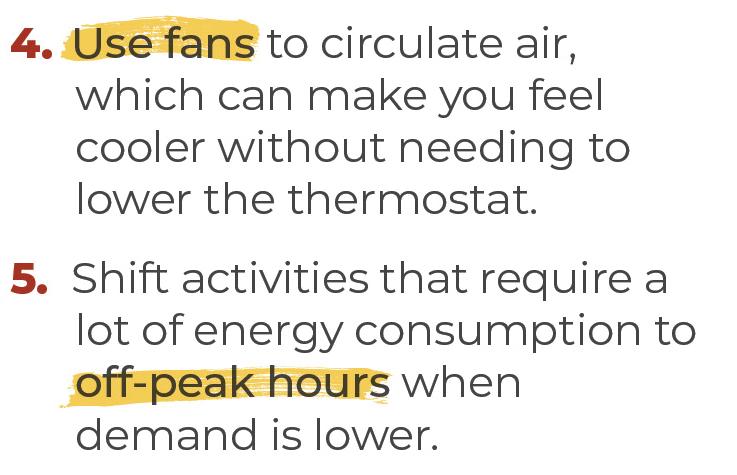

From babies and young animals to adults of all ages, Florida is filled with beautiful faces. The expressions you capture have a chance to brighten others’ days.
From time to time, we share some readers’ photos in this space. If we use your photo here, we will send you your choice of a $25 gift card to REI or Amazon.
To submit your photo, email a JPEG file to photos@ floridacurrents.com. Include “Before You Go” in the subject line. Please share a bit about what inspired you to make your photo.
Coconut, a rescue pup, is all smiles during his first day with his new family in Florida. PHOTO COURTESY OF BRI PANIAGUA

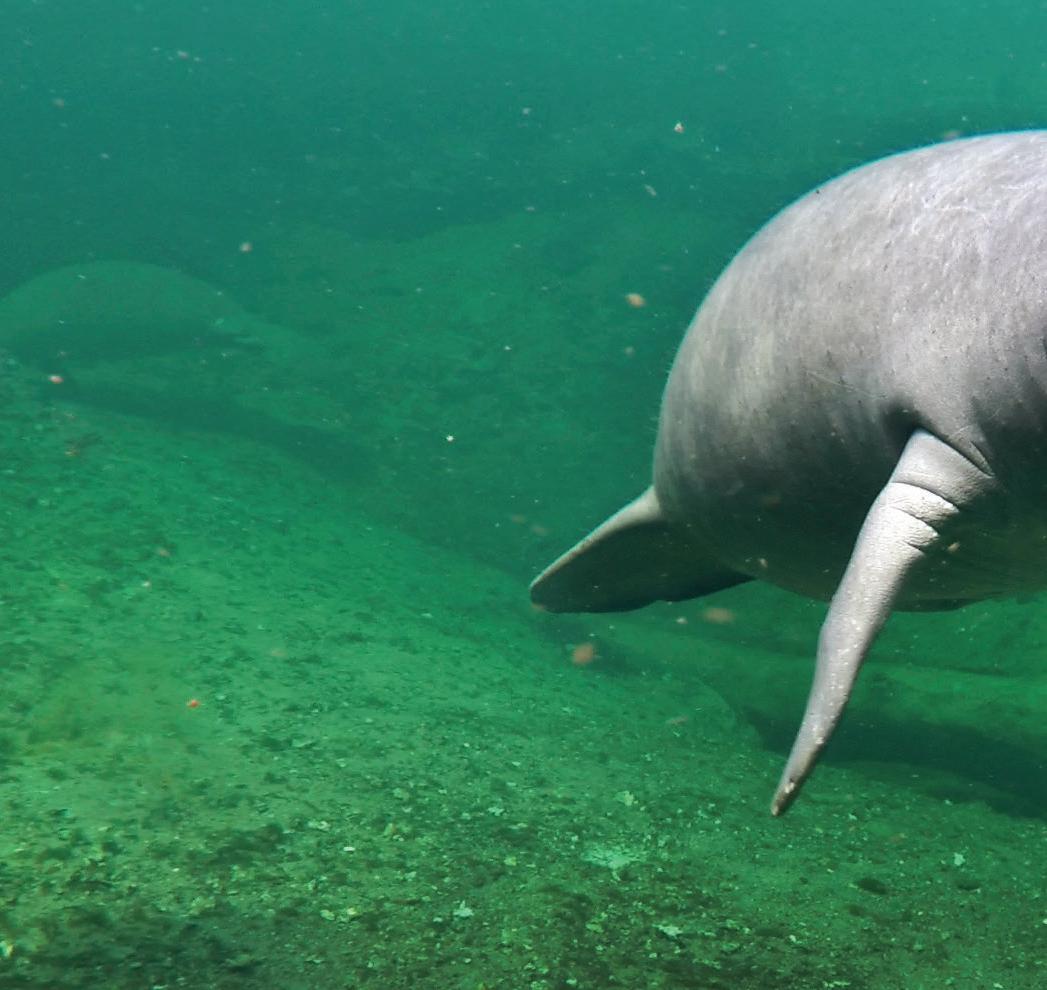




the greatest national parks of America’s Southwest!—Book
Welcome to a great vacation at an affordable price. These quality tours feature complete sightseeing, professional Tour Directors, and great itineraries. Discover for yourself why smart shoppers and experienced travelers have chosen Caravan Tours since 1952.
See the greatest national parks of America’s Southwest! You’ll enjoy 2 nights in national park lodges near the South Rim of the Grand Canyon, 2 nights at Lake Powell Resort, and 2 nights near Zion National Park.
The #1 in value. Your Grand Canyon, Bryce & Zion tour is fully guided with all hotels, activities, and some meals. You’ll explore Grand Canyon, Bryce, Zion, Lake Powell, Monument Valley, Antelope Slot Canyon, Sedona, and more!—Book now for choice dates:

Scan for Grand Canyon, Bryce & Zion 8-Day Tour $2195
Enjoy complete sightseeing with more visits, extra features, and local guides. Caravan includes all activities listed in the tour itinerary. Caravan does not sell any optional activities which can add hundreds of dollars to your tour price. Your free time is scheduled in great settings where there is no need to buy additional expensive activities.
Our 73rd year of excellence. Caravan has operated fully guided tours of superb value under the same family management and ownership since 1952.
“Brilliant, Affordable Pricing” Arthur Frommer,
Travel Editor
www.erec.com
JAY OFFICE WALNUT HILL OFFICE
3425 Highway 4 4950 Highway 99A
P.O. Box 428 (mail) Walnut Hill, FL 32568 Jay, FL 32565
PHONE NUMBERS
850-675-4521 800-235-3848
Walnut Hill Post O ce: 850-327-4122
OFFICE HOURS
7:30 a.m. to 4 p.m. Monday through Friday
STAFF
Ryan C. Campbell, P.E., CEO
Sonya Dooley, Director of Finance and Administration
Lanie Sells, Director of Engineering
Glenn White, Director of Operations
Cortney Owens, Manager of Communications
Derek Bridwell, Manager of Information Technology
Crystal George, Manager of Accounting
TRUSTEES
Escambia County
Brian Davis
James E. Hall
Ernie Hester
Sam Walker, Vice President
Gary Wiggins
Santa Rosa County
Mickey Diamond
Rick Hunsucker, President
Philip Marshall
Wesley Scott
Dale Westmoreland, Secretary/Treasurer
The board of directors meets at 5 p.m. the third Monday of each month at the cooperative’s Jay office.
FOR POWER OUTAGES
Call 877-OUT-EREC or 877-688-3732. For emergency conditions, call 911.

When you call EREC with a question about your bill, please have your account number. This allows us to serve you in the most efficient manner possible. Your bill is due and payable upon receipt. Payment may be made by mail, at www.erec.com, at our night depository at the co-op office or in person at the co-op office. We ask you to allow five days for mail and delivery to ensure we receive your payment on time. Your electric service is subject to disconnection if payment is not received in the office by the collection date, even though you may have mailed the payment. Accounts not paid within 15 days from the date printed on the bill will receive reminder notices showing the account will be disconnected if not paid. Return check charge is $25 or 5% of the check, whichever is higher.